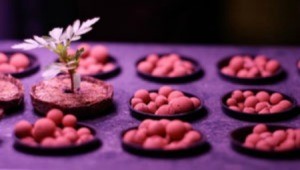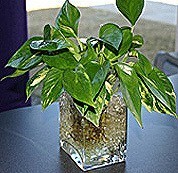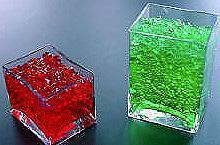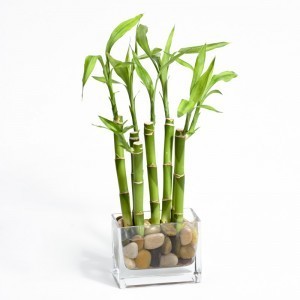 Who needs dirt? Not your houseplants, at least not all of them. Many can be cultivated using a technique called Hydroculture, where soil is replaced with water and a liquid fertilizer, and a clay aggregate is used to support the plant's roots. For people who travel a lot, or for those of us who tend to over or under water our houseplants, Hydroculture may be a good solution.
Who needs dirt? Not your houseplants, at least not all of them. Many can be cultivated using a technique called Hydroculture, where soil is replaced with water and a liquid fertilizer, and a clay aggregate is used to support the plant's roots. For people who travel a lot, or for those of us who tend to over or under water our houseplants, Hydroculture may be a good solution.
Plants are grown in containers filled with water and liquid fertilizer. The plants take in nutrients from a water solution through their "water" roots. After continuously being submerged in water, they have adapted by developing a greater capacity to store oxygen. Once the hydroculture system has been set up, a float in the reservoir indicates when it's time to add more solution.
Reduces pests and disease. No soil means no more soil born pests, including those creepy little potting soil gnats. You can also say goodbye to mold spores and mildew-a boon for those who suffer from allergies.
Lower maintenance. Hydroculture is cleaner and easier to maintain. By eliminating dirt, you eliminate must odors and messy spills. You'll need to water less often, transplant less often, and worry less about leaving your plants unattended while on vacation.
This page contains the following solutions.
You don't need to have a green thumb to grow houseplants in water. Even if you've killed every houseplant growing in soil that you have ever had, your success is almost guaranteed when growing them in water.
I began growing plants in water when I was trying to root a plant cutting that I had. I loved being able to see the roots as they grew so I decided to leave the cutting in water instead of planting it.
Here are the questions asked by community members. Read on to see the answers provided by the ThriftyFun community.
I've tried many times to get cuttings to sprout in water. They just get slimy. What can I do to have some luck?
You need to change the water daily. Once roots come, you should use rooting hormone and pot it up.
A lot of cuttings don't need to be started in water. Things like wandering jew and baby (or mouse-ear) jew can be stuck in the dirt and will grow just fine. I have purple jew ground-cover growing outside that I started from one cutting over 5 years ago, and it freezes and comes back every year.
I will start ivy in water, but like Judy says, water should be changed every day. I've found that sweet potato vines will grow if I just stick them in the dirt, either outside or in a pot. I even found a small sweet potato growing in a pot in my kitchen a few weeks ago. We used to put sweet potatoes in water to make a plant, but now if a sweet potato sprouts, I'll cut off the sprouts and put them in dirt.
What kind of plants are you starting?
I start spider plants in water. They stay in it for a few days until the roots sprout and then go into dirt that gets watered daily. This short time the water does not get slimy.
Kalanchoes on the other hand, I root directly into dirt and water them daily. They don't seem to root well for me in water.
African violets get set up in a special water rooting method with saran wrap and water changed every couple of days until they root.
Philodendren and pothos can be rooted either way.
The trick when using water rooting is, when you change the water, to wipe out the container and dry it before adding the fresh water. The only time I get slime is when I don't do this.
Happy rooting!
If you are trying to root cuttings in water the process isn't that necessary now. You can use some florist foam to put the cutting in. You will cut a small square of the foam and inset the cuttings in the foam. Now you just sit this in a small dish with some water in the dish. The foam will soak up the water and root the plants. Once they are rooted you can plant them in the ground. This is much easier than trying to put them in a glass of water to root.
Back in the mid 70s there was a company that offered their house plants through home parties. The plants were grown in some kind of lava looking pebbles and did not use soil at all. You watered with their plant food solution each time you watered. The plants grew beautifully! Does anyone know what happened to the company or know what type of pebbles and solutions were used?
Hardiness Zone: 7a
By Daisy from Franklinton, NC
I was a dealer in Iowa, I sold plants like crazy but the company I worked for went bankrupt. Hydroponics is what you are looking for, and yes it was lava rocks. However, weak miracle grow and a air pump from an old fish tank works great to grow soil-less plants.
was is called the Lawasa System?
Thank you! My sister had some of those planters/rocks, here in NC, back in the 70's....& I have wanted to know how to get them, & you have just been a huge help to me. Thanks again! Susan
Probably hydroton or lightly expanded clay pellets
I gave many "plant parties" back in the day. Found out by trying it out myself that using small lava rocks from Lowe's and plain water in any kind of container works great for any plant that can be grown in water. Use plant fertilizer sparingly a couple of times a year. There are enough nutrients in the lava rock for pothos to last for years. I grew them in fish bowls for coffee tables for friends.
Can I grow indoor plants in water only? What do I do with indoor plants in water when the water begins to smell bad? Other than replacing all the water.
Hardiness Zone: 6a
By marian nelson from Provo, UT
I have seen plants grow in these greatly expanding crystals.
www.watercrystals.com/
They also say:
" Water by itself is not a sufficiently nutritional diet. We recommend adding a few drops of liquid minerals to help provide nutrients to your plants in this new and any other growth media for your plants."
They sell this stuff (above) but I think that liquid "Miracle-Gro" would also work. You'd only need a drop every few weeks or once a month.
Here's apicture of their website:

You can also add food coloring to the crystals:

I remember my mom growing sweet potato vines (as house plants) in a mason jar. How do you do it? I'd love to know. Can they remain in the water with some marbles in the bottom, or do they need to be planted? What type of light do they need? If I need to plant them, what do I keep the moisture level at for the soil?
You put the end that is "pointed" down in the water in the jar. You can grow these in your kitchen window or anywhere else in your home, where there is natural sunlight. Once you put the potato down in the jar, only about half of the potato should be in the water. You don't ever have to plant these. From what I could tell, they could live indefinitely in the jar.
I hope this helps.
I grow them every year with my kids in school...they enjoy watching the vine grow
My sweet potato in the jar keeps getting moldy. I just moved it to a window that gets more direct light, but does anyone have another suggestion?
lavell1 @ comcast.net (remove spaces)
hello,
the first thing you do is you get a jar and fill it with water(make sure you leave an inch without water).then insert the root end in the jar make sure that the end was in the water
I tried to grow a vine from a sweet potato, and it only rooted a little, my sister told me that my mom use to cut one end off, but do you put the cut in down in the water or up out of the water? I didn't cut an end off and the potato rotted!""
I tried the sweet potato in the mason jar thing. I used the tooth picks and changed the water every other day and kept it in a sunny window. But after a week the part that was immersed in water rotted! What did I do wrong? Dana in Pa
Can u eat them? I have them growing like crazy.
I'm trying to grow an Okinawan sweet potato. I soaked the long part of the potato. That part started to rot. So I cut the rotted part off and turned it around.
So can anybody tell me if that is right or wrong? Anyone in Hawaii?
You should put the pointed end of the potato into the water. Let about 1/3 of the potato stick out the top of the jar three or four toothpicks. Sunny warm window or on top of the fridge. Add water as needed. Should be good to go...er grow! Very easy plant and pretty, too.
I think success/failure depends a lot on how long the potato was in cold storage before you bought it. So try again, after you ask your friendly produce manager!
Stick a toothpick on each side so the bottom tip is in water. It will get sprouts everywhere. Be sure you put it in a place, or window for light. Once it starts growing it is nearly impossble to move. Mine I have just added water, but 2 drops of mirale grow probably wouldn't hurt.
I have been growing plants in bottled water for over fifty years. Recently we installed a whole house water filter and I now have a rim of scum (?) on the top edge of the water and on the container.
The containers are cleaned thoroughly and the water is changed every month and it does not matter the size of the container or the type of plant.
I have a couple of plants in vases, but the water seems to start smelling bad after a few weeks. What can I do or what should I put in the water to prevent this from happening?
I would like to have a vase on my desk with a plant in water. Which plants will grow this way?
By RL from Basking Ridge, NJ
Pothos will do well in water with good filtered light. Google the image, it's a common plant.
Any of the philodendrons will root and grow in water, ivies will as well.
For some foliage colour (if you get a fair amount of sun at that spot) you can try some of the spiderworts, like 'wandering Jew' or 'Moses in the bulrushes'-use the word Tradescantia in your search engine to find images. These do have some flowering but I've never seen them flower whilst in water as the only growing medium.
Be advised most plants like these will develop brittle roots and eventually die; even water lilies want some soil to thrive and flower.
Bamboo does well this way also. In Dallas where I live, attractively-potted bamboo plants with rocks and water are very easy to find at Home Depot, Lowe's, and even grocery stores.

I'm doing a science fair project on how different liquids effect how plants grow. I'm growing radishes, pole bean and peas in orange juice, diet ginger ale, milk, water and diluted vinegar. I need some research on how each liquid can effect my plants. Can you help?
By Tally from Ontario, Canada
Tally,
I typed a search into Google, and this is what came up. Remember to cite your sources!
www.google.com/

I would call your county extension office, maybe they can help you, good luck.
In our area, we have a County Extension Agent who is very knowledgeable about the soil, plants, and so on in our particular area.
The County Extension Office offers a multitude offers of help. They will mail leaflets and brochures to you. Our extension agent will test the soil for you. And advise what should be added to your soil for the particular plants you'd like to grow. They also have a "test" garden here, which shows the plants that grow well here. They offer workshops for pruning grapevines and fruit trees. There is just a multitude of things available thru this office. I imagine they would be very helpful to you and your Science projects.
I need to know what steps to take when changing the water that my ivy roots live in? Can I just dump out the old water and put fresh water in the vase my ivy lives in without killing it.
Yes, you can. It's best to use water that has been drawn for about 24 hours. That time gives the chlorine in the water a chance to dissipate.
My Ivy does best doing a dump of about 80% of the water and refilling it with bottled spring water
 I've had my indoor ivy plant, which I have grown in water, for a couple of years now without a problem. I trim the roots when they get too long and clean off any algae that may arise from the sunlight.
I've had my indoor ivy plant, which I have grown in water, for a couple of years now without a problem. I trim the roots when they get too long and clean off any algae that may arise from the sunlight.
A couple of days ago I did the same and noticed this thick black "scab" all over the stems. Now my leaves are all turning yellow. Anyone, any ideas on how to solve this issue?
By Franceska Marie McCaughan O.
I think that is a philodendron or a pothos, not an ivy. Usually, they go yellow when they are not getting enough of something: water, light, nutrients. Since you have been growing them in water for so long, have you been adding any plant food to the water? I don't know anything about the black scab but maybe someone else will have some other ideas. Good luck.
Some lily bulbs can successfully be grown in a water and stone filled vase. However, if the vase is clear the water may also support algae growth. After cleaning the rocks replant in an opaque or wrapped vase. This is a page about removing algae from water in which an oriental lily bulb is growing .